|
|
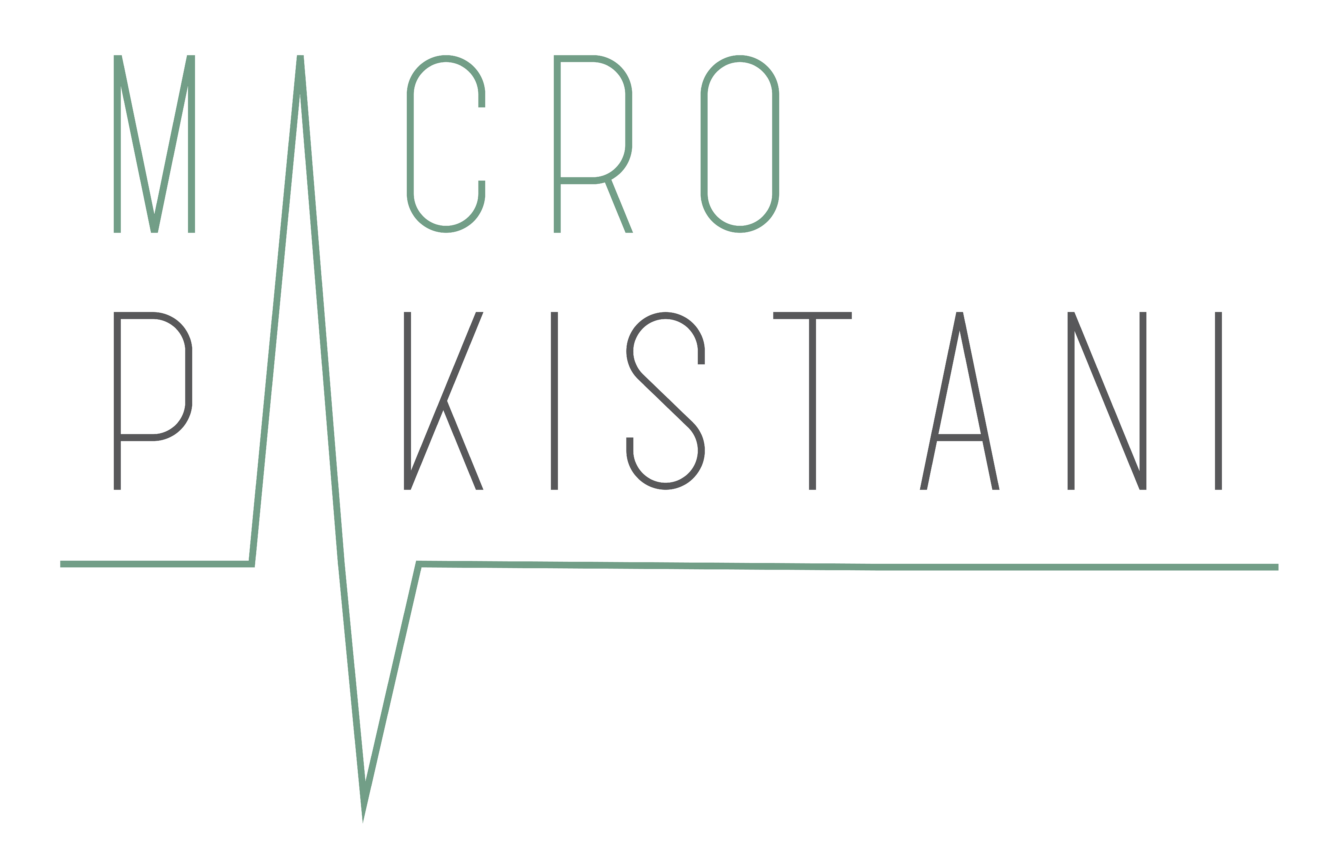
|
|
|
|
|
|
|
Good evening [subscriber:firstname | default:Subscriber]!
|
At Macro Pakistani, we often speak to subject matter experts to validate the data analysis we conduct. In our discussion with an expert on education, we were told “Alhumdulillah! Pakistan is now expected to spend as much on public education as it does on the military.” The expert was comparing budgeted data on education spend with military spend reported officially. Both were expected to be 3% of GDP. As we dived a bit deeper into the data, we realized his optimism was misplaced.
|
|
|
|
Why have expenditures remained high for military in Pakistan?
|
Below are the numbers for 2019 we uncovered:
|
- Public education actual spend: 2.3% of GDP
- Public health actual spend: 1.1% of GDP
- Public health and education combined: 3.4% of GDP
- Military actual spend: 3.7% of GDP
|
Pakistan spends more on its military than public health and education combined. As mentioned before, this is less than half the emerging market average of 7.6% of GDP.
|
|
A global leader
|
|
Pakistan leads most countries in defense spending as a proportion of GDP. Its ‘military burden’ is the 9th highest in the world, above the US, India and China. It spends around 4% of GDP on its military compared to the global average of 2.2%.
|
|
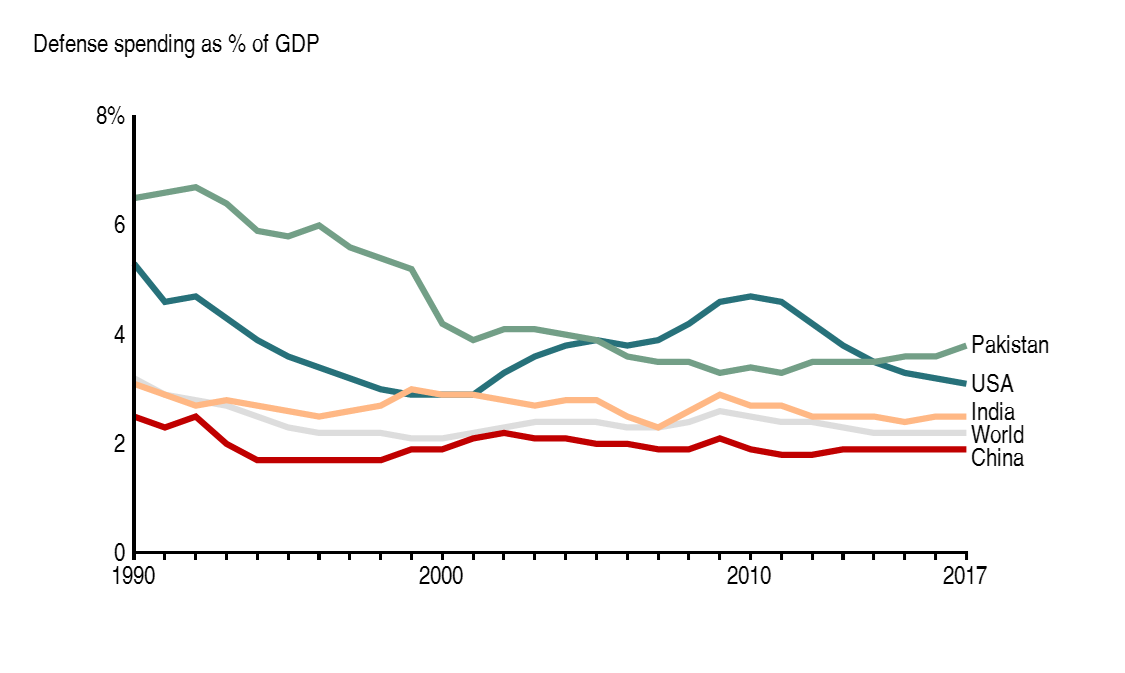
|
Source: World Development Indicators
|
|
The denominator of GDP in measuring military burden is significant. Pakistan does not spend more than the United States on its military. In fact, the US spends over 70 times more. But because Pakistan’s GDP is relatively small, the military expenditures appear outsized. The burden would reduce if a country’s GDP grows faster than its military expenditures. If Pakistan has rapid real GDP growth and military expenditure increases based on inflation alone, the burden would fall each year.
|
|
Pensions are hidden
|
|
The reason our education expert was mistaken was because reported military spend is actually 3% of GDP. Pakistan understates its defense expenditure by reporting military pensions under the civilian budget.
|
|
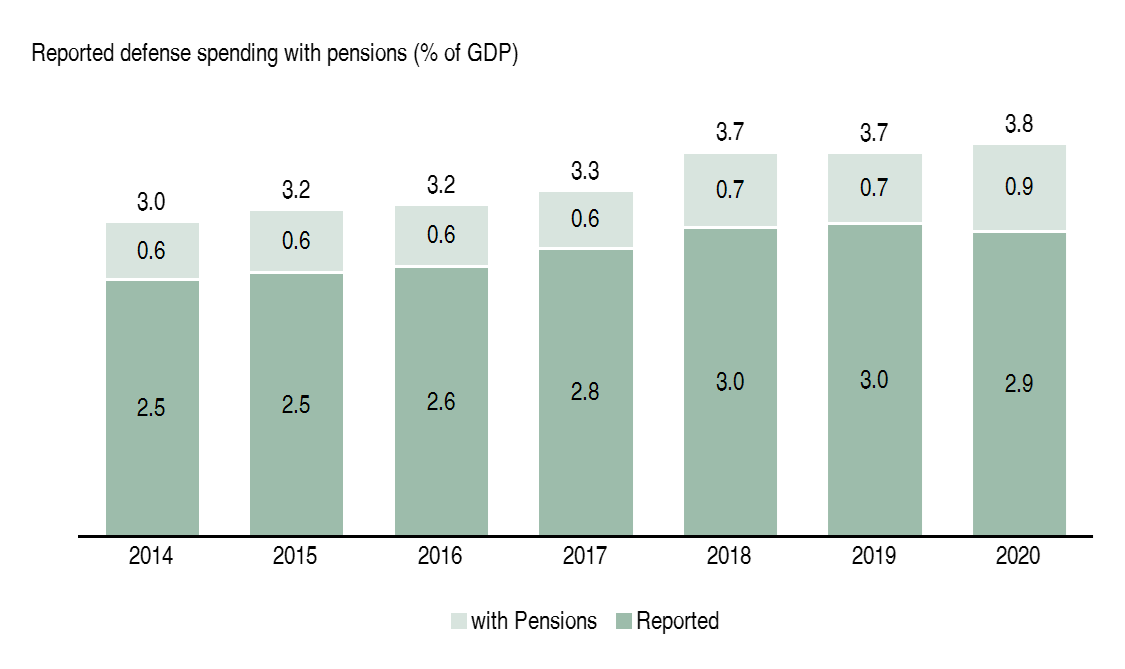
|
Source: Economic Survey of Pakistan 2019-20; Budget in Briefs (2014-21)
|
|
This accounting tactic started mysteriously in July 2000, when former army chief General Pervez Musharraf was ruling the country. To date, no valid explanations have been provided on why that change was made. Reporting military pensions separately is not the norm. Pensions make up around 25% of India’s defense budget and are reported within the 2% of GDP that they report spending on their military.
|
|
Pensions are a problem
|
|
Pensions for the military in Pakistan make up over 75% of the federal government’s pension expenditures. Expenditure on retired military personnel is more than thrice the amount spent on retired federal government employees.
|
|
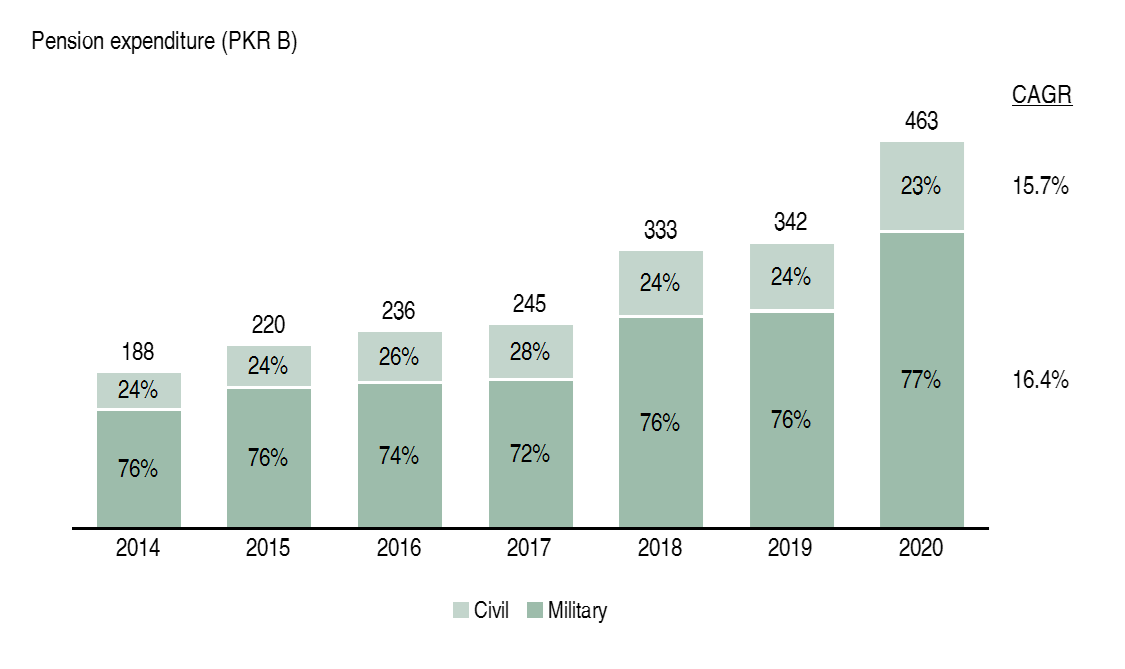
|
Source: Budget in Briefs (2014-21)
|
|
Pensions is a topic on its own that Macro Pakistani would like to explore. For now, just know that these pensions are unfunded, with no provision by the state to finance future liabilities. This will mean this pension balance will continue to grow in the near future for all military, federal and provincial government employees. If you want to explore the current broader issue, you can do so here.
|
|
Save the people
|
|
Since most cite neighboring India as the reason behind Pakistan’s outsized spend on its military, a side-by-side analysis would help. India is a larger country with almost seven times the population. It also spends seven times more on its military. While Pakistan spends around USD 10 billion on defense, India now spends more than USD 70 billion. It has increased per capita spend twice as fast as Pakistan, with both countries competing in the name of national security.
|
|
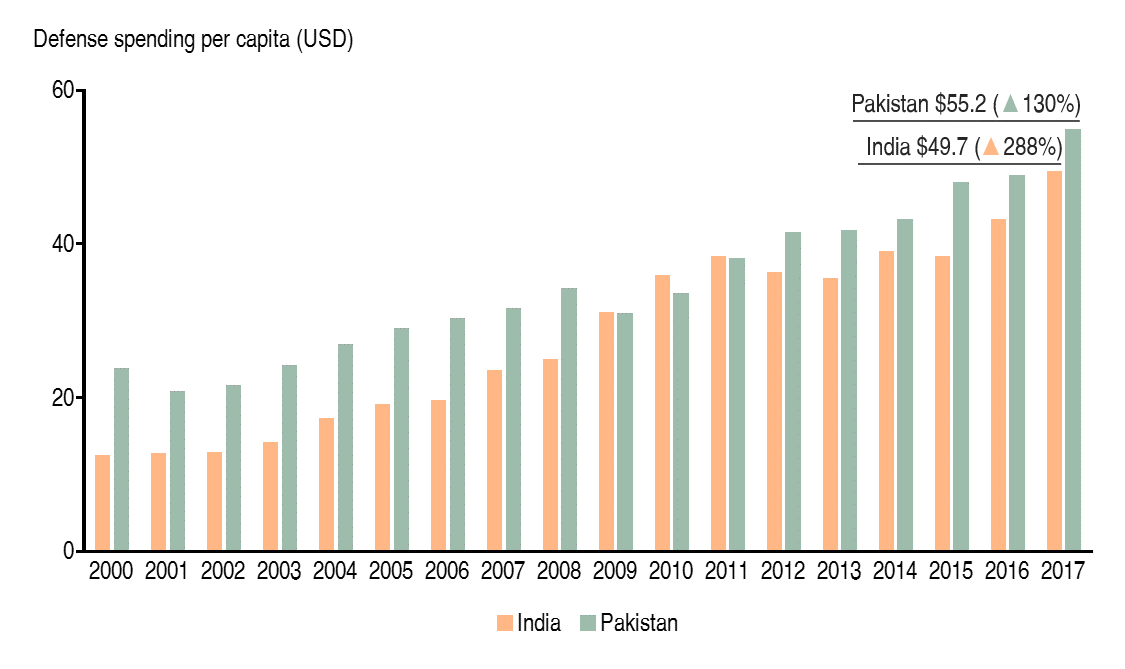
|
Source: Economist Intelligence Unit
|
|
While both countries now spend around USD 50 per capita on defense, India’s military burden did not change much even as its per capita spend increased. Faster economic growth allowed it to allocate a higher budget to its military without increasing the proportion of GDP attributed to it. Economic growth can allow Pakistan to continue to spend the same nominal amount on defense while reducing military burden. It can also help the country allocate more funds toward improving human development outcomes we have discussed before.
|
|
We need the US
|
|
Since independence, Pakistan has received over USD 30 billion in direct aid from the United States. About half of this was for military assistance and more than two-thirds was disbursed post 9/11. This aid has been a major force in ensuring the military might of the country. If you scroll back up to the first chart and see when Pakistan’s military expenditure started falling and the same for when the United States’ started increasing, you will see that it happened around 2001. After that, the US started a Coalition Support Fund as part of the War on Terror, of which Pakistan was a major benefactor.
|
|
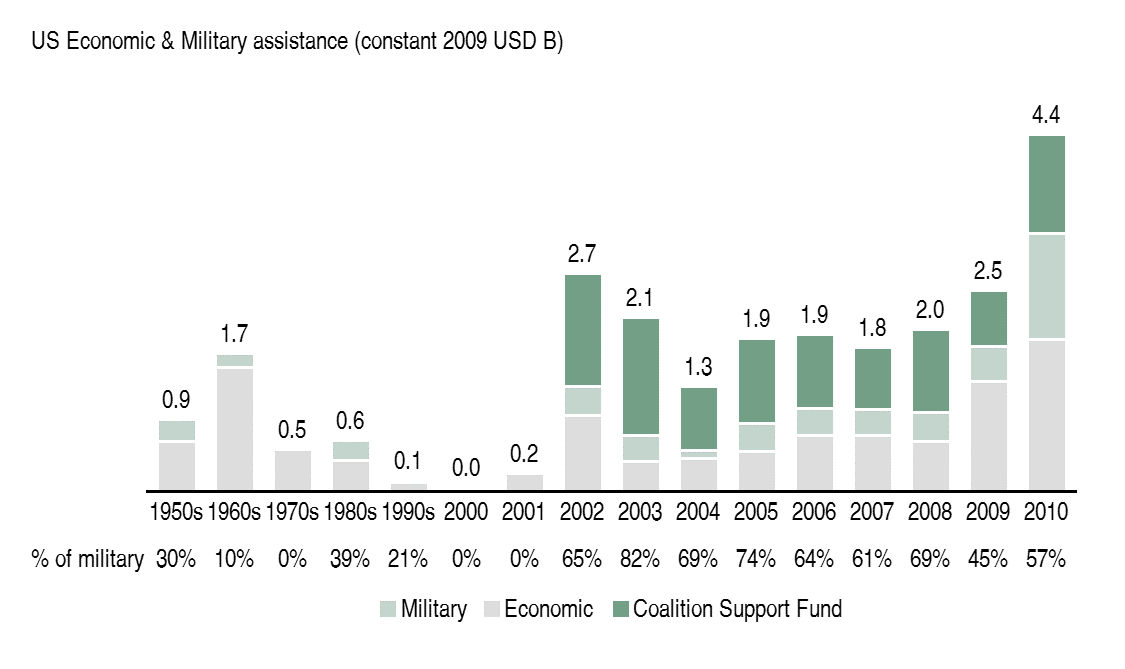
|
Source: US Overseas Grants and Loans database; Congressional Research Service
|
|
Read the full article below if you want a short overview of the fascinating history of US aid to Pakistan. What is important to note is that increases in both economic and military assistance came in times of military rule (1960s, 1980s and 2000s). Pakistan’s international relations and military prowess are very closely linked. Next time, we will talk about international relations and their economic impact more broadly, with a discussion on Pakistan’s current account.
|
|
|
|
|
Read the full article in the link below
|
|
|